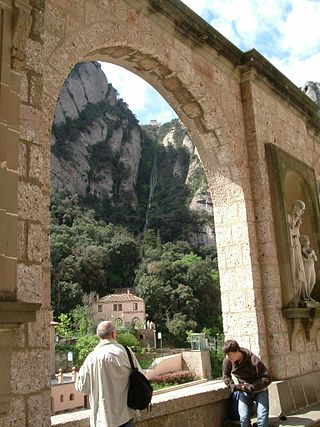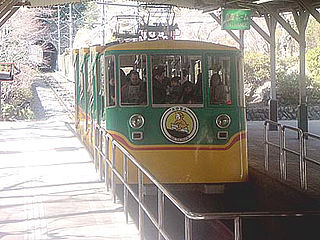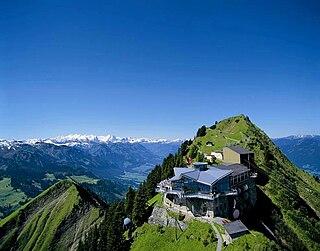
Ferrocarrils de la Generalitat de Catalunya, or FGC, is a railway company which operates several unconnected lines in Catalonia, Spain.

The Peak Tram is a funicular railway in Hong Kong, which carries both tourists and residents to the upper levels of Hong Kong Island. Running from Garden Road Admiralty to Victoria Peak via the Mid-Levels, it provides the most direct route and offers good views over the harbour and skyscrapers of Hong Kong. Operated since 1888, it was the first funicular railway in Asia.

The Lauterbrunnen–Mürren Mountain Railway is a hybrid transport system in the Bernese Oberland area of Switzerland, which connects the villages of Lauterbrunnen and Mürren. The system consists of a connected aerial cableway, also known as the Grütschalpbahn, and an adhesion worked mountain railway. The cableway replaced a funicular, on the same route, in 2010.

The Skitube Alpine Railway is an Australian standard gauge electric rack railway in the Kosciuszko National Park in New South Wales. It provides access to the snowfields at Blue Cow Mountain and the Perisher Valley.

The Montserrat Rack Railway is a mountain railway line north-west of Barcelona in Catalonia. The line runs from Monistrol de Montserrat to the mountain-top monastery of Montserrat.

The Fløibanen is a funicular railway, owned by Fløibanen AS, in the Norwegian city of Bergen. It connects the city centre with the mountain of Fløyen, with its mountain walks and magnificent views of the city. It is one of Bergen's major tourist attractions and one of Norway's most visited attractions. The line is 848 m (2,782 ft) long, covers a height difference of 302 m (991 ft), and carries nearly two million passengers a year.
The Guindais Funicular is a funicular railway in the Portuguese city of Porto. It connects the Praça da Batalha, situated uphill to the north, with Cais dos Guindais, by the riverside to the south. The upper station is by the terminus of the vintage tram line 22 and within walking distance of São Bento station for metro and railway connections. The lower station is by the lower level of the Dom Luís I Bridge and within walking distance of the Praça da Ribeira.

The Gelida Funicular is a funicular railway in the municipality of Gelida in Catalonia, Spain. The line connects Gelida station, on the RENFE, with the centre of the village of Gelida, which is at a higher level. The line was opened in 1924 and modernised in 1984, whilst retaining a heritage ambience.

The Sant Joan Funicular is a funicular railway at Montserrat, near Barcelona in Catalonia, Spain. The line connects the monastery, and the upper terminus of the Montserrat Rack Railway, with sacred sites, walking trails and viewpoints higher up the mountain. With a maximum gradient of 65 %, it is the steepest funicular in Spain.

The Santa Cova Funicular is a funicular railway at Montserrat, near Barcelona in Catalonia, Spain. The line descends from the monastery, and the upper terminus of the Montserrat Rack Railway, on a continuous curve to a lower station that gives access, via a path, to Santa Cova, a shrine lower down the mountain.

The Takaotozan Railway is a transport company in Hachiōji, Tokyo, Japan. The company operates a funicular line and a ropeway to Mount Takao, a popular destination for mountain trekking among Tokyo residents. The company was founded on September 29, 1921.

The Trieste–Opicina tramway is an unusual hybrid tramway and funicular railway in the city of Trieste, Italy. It links Piazza Oberdan, on the northern edge of the city centre, with the village of Villa Opicina in the hills above.

The Stanserhorn is a mountain in Switzerland, located in the canton of Nidwalden near the border with Obwalden, with the peak at 1,898 metres (6,227 ft) above sea level.

Trams in Bogotá were first inaugurated on December 24, 1884 with the first tramway pulled by mules, covering the route from Plaza de Bolívar to San Diego, in Bogotá, Colombia. In 1892, a tramline linking Plaza de Bolívar and Estación de la Sabana started operating. The original trams ran over wooden rails but since such tramways easily derailed, steel rails imported from England were later installed. In 1894, a tramcar ran on the Estación de la Sabana to Chapinero line every twenty minutes.

Bulnes is one of nine parishes in Cabrales, a municipality within the province and autonomous community of Asturias, in northern Spain.

The Central Funicular, is one of four funiculars in the public transportion system of Naples, Italy. The system is a true funicular: an inclined railway with two passenger cars, connected via cables, operating in concert.

The Dolderbahn is a 1.3 km (0.81 mi) long rack railway in the Swiss city of Zürich. The line is in Zürich's Hottingen and Fluntern suburbs on the south slope of the Adlisberg mountain. The lower terminus of the line is at Römerhof, some 1.5 km (0.93 mi) from the city centre, where it connects with lines 3 and 8 of the Zürich tramway. The upper terminus at Bergstation Dolderbahn is adjacent to the Dolder Grand Hotel and the Dolder recreation area. Two intermediate stations, at Titlisstrasse and Waldhaus Dolder, are also served.

Peu del Funicular is a railway station in the Sarrià-Sant Gervasi district of Barcelona. It is served by lines S1 and S2 of the Metro del Vallès commuter rail system, and is also the lower terminus of the Funicular de Vallvidrera. Both commuter rail and funicular are operated by Ferrocarrils de la Generalitat de Catalunya, who also run the station.

The Rheineck–Walzenhausen mountain railway is a 1.9 kilometres (1.18 mi) long rack railway in Switzerland. It links Rheineck station, in the municipality of Rheineck and the canton of St Gallen, with the village and health resort of Walzenhausen, in the canton of Appenzell Ausserrhoden. Passenger service on the line now forms part of the St. Gallen S-Bahn, branded as the S26. The S26 is also part of the Bodensee S-Bahn.





















